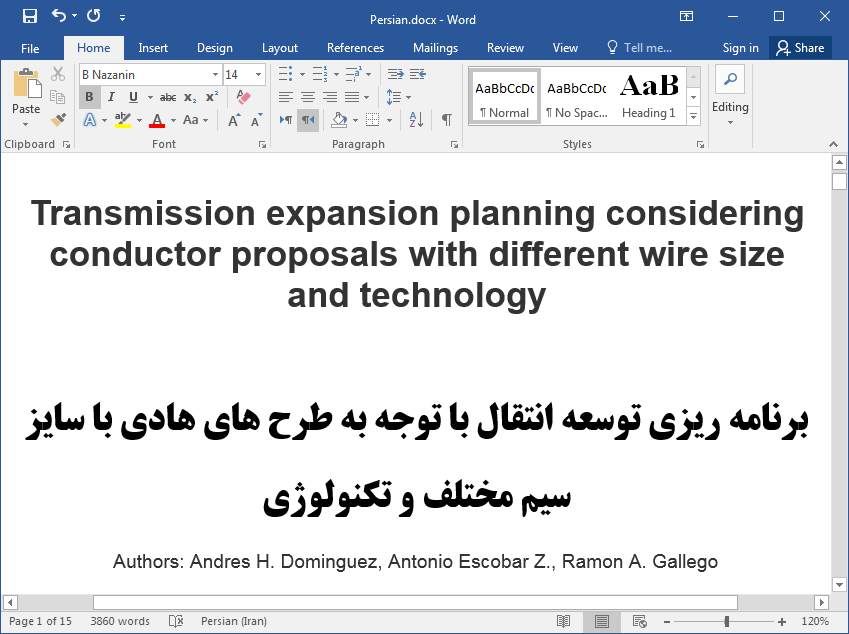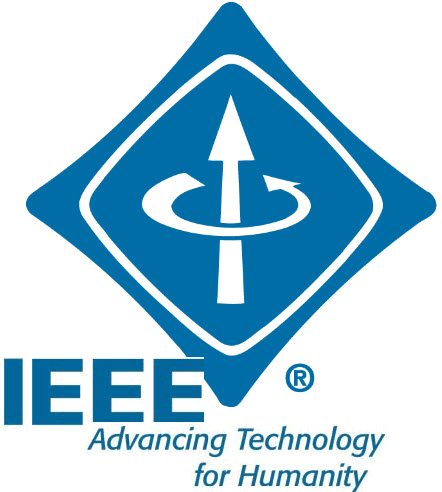برنامه ریزی توسعه انتقال با طرح پیشنهادی هادی و تکنولوژی


13,500 تومانشناسه فایل: 8795
- حجم فایل ورد: 222.1KB حجم پیدیاف: 217.7KB
- فرمت: فایل Word قابل ویرایش و پرینت (DOCx)
- تعداد صفحات فارسی: 15 انگلیسی: 6
- دانشگاه:Department of Electrical Engineering, Technological University of Pereira, Colombia
- ژورنال: 2014 IEEE PES Transmission & Distribution Conference and Exposition - Latin America (PES T&D-LA)
چکیده
در این مقاله، یک مدل و راه حل برای حل مسئله توسعه شبکه انتقال، با توجه به انتخاب اندازه سیم و تکنولوژی ساخت هادی های خطوط انتقال برای هر خط جدید، ارائه شده است. مسئله بهینه سازی با استفاده از یک الگوریتم ژنتیک تخصصی، حل می شود که از یک منطق الگوریتم ژنتیک Chu-Beasly ترکیب شده با یک فناوری دقیق استفاده می کند. روش در سیستم الکتریکی کلمبیایی از 93 مسیر و 155 خطوط نامزد، امتحان می شود، که به منظور اجازه دادن به گزینه های سرمایه گذاری برای انتخاب هادی ها، اصلاح می شود. نتایج به دست آمده، راه حل سنتی برای سیستم الکتریکی کلمبیا را در مطالعه ی برنامه ریزی انتقال را بهبود می بخشد.
مقدمه مقاله
مسئله توسعه شبکه انتقال انرژی الکتریکی سنتی، سرمایه گذاری های جدید خطوط انتقال و پست های فرعی را تعیین می کند. سرمایه گذاری های جدید باید یک انتقال جریان انرژی الکتریکی مناسب بین موقعیتهای مختلف در سیستم نیرو با در نظر گرفتن عملیات فعلی و آینده، را اجازه بدهد. خصوصیات گزینه های سرمایه گذاری، قیمت های بالا، دوره ی ساخت طولانی و وصول طولانی مدت سرمایه گذاری است. مطالعات برنامه ریزی سیستم فعلی را به عنوان معیار و با توجه به یک تقاضای افزایش یافته در مسیرهای سیستم، همچنین جایگزین ها در واحد نیروی جدید، ارتقاء واحد قدرت موجود و تمام موارد فوق در یک افق زمانی از 10 سال یا بیشتر را در نظر می گیرد. برنامه ریزی آماری، حداقل هزینه ی راه حل از یک روش بهینه ی ریاضی را تخمین می زند که شبکه ی کنونی قسمتی از راه حل آینده در نظر گرفته می شود، یعنی در حل مسئله، حذف، حرکت یا عدم اتصال به یک روش دائمی، عناصری که عامل در شبکه ی کنونی است، اجازه داده نمی شود. مسئله ی برنامه ریزی توسعه ی سیستم انتقال انرژی الکتریکی یک مسئله ی برنامه ی غیرخطی عدد صحیح مختلط می باشد و Np-کامل است که یک مسئله ای است بر اینکه هیچ روشی وجود ندارد که آن را در زمان چند جمله ایی حل کند. این مسئله یک تعداد زیادی از راه حل های بهینه ی محلی را ارائه می دهد و برجسته نیست. مسئله به طور موفقیت آمیزی با استفاده از تکنیک های بهینه سازی دقیق حل نمی شود وقتی اندازه ی سیم بزرگ می شود، یک مقدار محسوسی از مسیرهای ایزوله شده دارد زیرا تعدادی از راه حل ها به طور نمایی رشد می کنند. از طرف دیگر وقتی اندازه ی سیم کوچک یا متوسط باشد، راه حل بهینه با استفاده از تکنیک هایی مانند Branch و Cut یا Branch و Bound یافت می شود. در این حالات، یافت می شود که سیستم های کامپیوتری نیازمند مقدار زیادی زمان محاسبه می باشد که با زمان مورد نیاز توسط تکنیک های فراابتکاری مانند بررسی Tabu (TS) یا الگوریتم ژنتیک پیشنهاد شده توسط Chu و Beasley (GACB) مقایسه می شود. مسائلی که هم PNLEM و NP-کامل می باشند برای حل بسیار مشکل می باشند. برای حل مسئله ی برنامه ریزی انتقال، چندین ر.ش حل از تکنیک های ابتکاری و روش دقیق برای تکنیک های ریاضی استفاده شده است. نوشته جات تخصصی، چندین روش ریاضی را گزارش می کنند که برای حل مسئله ی برنامه ریزی استفاده شده است. در [9] یک نوع برنامه ریزی خلاصه یافت می شود. در [10] یک رتبه ایی از الگوریتم ها غالباً استفاده شده، ارائه می شود. از طرف دیگر، چندین پژوهش که شامل مسئله ی برنامه ریزی توسعه ی انتقال می باشند، در [11] یافت شده است.
در این مقاله یک راه حل ارائه می شود که مدل سنتی استفاده شده برای حل مسئله ی برنامه ریزی توسعه ی انتقال را تغییر می دهد، ما جایگزین های جدیدی از اندازه ی سیم مختلف و تکنولوژی ساخت هادی هایی برای خطوط انتقال را بررسی می کنیم که متعلق به مجموعه ایی از همه ی مسیرهای جدید است. نظر بر دادن مزیت فناوری تولید هادی های جدید برای افزایش ظرفیت انتقال، است. وقتی هادی های ACSR جایگزین هادی های پرظرفیت (HTLS) میشوند که ساختارهای مکانیکی مشابه ایی را استفاده می کنند، میتوانند مزیتی از مقیاس صنعتی را ایجاد کنند. الگوریتم ژنتیکی Chu-Beasley به عنوان روش راه حل استفاده می شود که در تدوین آن به دو قسمت تجزیه و تحلیل شکسته می شود. در اولین قسمت، تعریف می شود چه چیزی، کجا و چطور بسیاری از تجهیزات جدید در یک سیستم الکتریکی باید راه اندازی شوند و در دومین فاز، نوع هادی انتخاب می شود که باید در هر خط انتقالی در سیستم، استفاده شود. راه حل بدست آمده بعد از فرایند بهینه سازی باید بر عمل مناسب در یک تقاضای تولید آینده برای سناریوی با دوره ی طولانی، مطمئن باشد. در این مقاله 93 مسیر سیستم کلمبیایی و 155 حق گذر، به عنوان معیاری داده می شوند که برای رسیدگی هادیهای HTLS در پیشنهادات سرمایه گذاری خطوط انتقال جدید، اصلاح می شوند. نتیجه های بدست آمده نشان دهنده یک گرایش قوی جهت سرمایه گذاری در هادی های HTLS با قیمت پایین تر از آنچه که در مطالعات قبلی تعیین شده است.
ABSTRACT Transmission expansion planning considering conductor proposals with different wire size and technology
In this article a model and a solution methodology is presented to solve the transmission network expansion problem, considering the selection of the wire size and the construction technology of the conductors for transmission lines for each new right-of-way. The optimization problem is solved using a specialized genetic algorithm that uses the logic of the Chu-Beasley Genetic Algorithm combined with an exact technique. The methodology is tested in the Colombian electric system of 93 buses and 155 candidate lines, which is modified in order to allow investment options for the selection of the conductors. The results obtained improve the traditional solution for the Colombian electrical system in the transmission planning study.
Introduction
The traditional electrical energy transmission network expansion problem determines the new investments in transmission lines and substations. The new investments must allow a suitable electrical energy flow transfer between different locations in the power system taking into account both current and future operation. The features of the investment options are high costs, the long construction periods and the long time recovery of investment. The planning studies take the current system as benchmark and considering an increased demand in the buses of the system, also alternatives in new power units, upgrade existing power units, and all foregoing in a horizon time of 10 year or more. The static planning determines the minimum cost solution from a mathematical optimization problem approach that considers the current network like part of the future solution, i.e., in the solution of the problem is not permitted removing, moving or unconnecting in a permanent way, the elements that are operating in the current network. The electrical energy transmission system expansion planning problem is a mixed integer nonlinear programming problem, and is NP-complete, that is, a problem for which no method exists that solves it in polynomial time. This problem presents a large number of local optimal solutions and is not convex. The problem is not solving successfully using exact optimization techniques when system size becomes large, and the system has an appreciable amount of buses isolated, because the number of solutions grows exponentially. In other way, when the size system is small or medium sized, the optimal solution is found using techniques like Branch and Cut or Branch and Bound [1, 2]. In this cases, it is found that the computer systems require great amount of computational time when is compared with the time required by metaheuristics techniques like Tabu Search (TS) or the Genetic Algorithm proposed by Chu and Beasley (GACB) [3, 4, 5, 6]. The problems that are both PNLEM and NP-complete are the most difficult to solve. To solve the transmission planning problem several solution methodologies have been used ranging from the heuristic techniques and exact methods to metaheuristic techniques. Specialized literature reports several mathematic models that have been used to solve the planning problem in [7, 8]. In [9] is found a planning types summary. In [10] is presented a rating of the algorithms mostly used. On the other hand, several researches that include the transmission planning problem are found in [11].
In this paper is presented a solution methodology that alter the traditional model used to solve the static transmission expansion planning problem, we consider new alternatives of different wire size and construction technology of the conductors for transmission lines that belong to the set of all new routes. The idea is to take advantage of new conductors manufacturing technologies to increase the transmission capacity. When the ACSR conductors are replaced for high temperature and low sag conductors (HTLS) that utilize similar mechanical structures, can take advantage of economies of scale. The Chu-Beasley Genetic Algorithm is used as solution method, which in its codification broken up into two parts the analysis. In the first part is defined what, where and how many new equipment must be installed in an electric system, and in the second phase the conductor type is selected that should be used in each transmission line in the system. The solution obtained after the optimization process should ensure the suitable operation in a future generation-demand for a long term scenario. In this paper the 93-bus Colombian system and 155 right-of-ways is taken as benchmark, which is modified to take into account the HTLS conductors in the investment proposals of the new transmission lines. The results obtained show a strong trend toward the investment in HTLS conductors with values lower than those determined in previous studies.




- مقاله درمورد برنامه ریزی توسعه انتقال با طرح پیشنهادی هادی و تکنولوژی
- برنامه ریزی توسعه گسترش با توجه به پیشنهادهای هادی با سایز مختلف و تکنولوژی
- پروژه دانشجویی برنامه ریزی توسعه انتقال با طرح پیشنهادی هادی و تکنولوژی
- برنامه ریزی توسعه انتقال با توجه به طرح هادی با اندازه سیم متفاوت
- پایان نامه در مورد برنامه ریزی توسعه انتقال با طرح پیشنهادی هادی و تکنولوژی
- تحقیق درباره برنامه ریزی توسعه انتقال با طرح پیشنهادی هادی و تکنولوژی
- مقاله دانشجویی برنامه ریزی توسعه انتقال با طرح پیشنهادی هادی و تکنولوژی
- برنامه ریزی توسعه انتقال با طرح پیشنهادی هادی و تکنولوژی در قالب پاياننامه
- پروپوزال در مورد برنامه ریزی توسعه انتقال با طرح پیشنهادی هادی و تکنولوژی
- گزارش سمینار در مورد برنامه ریزی توسعه انتقال با طرح پیشنهادی هادی و تکنولوژی
- گزارش کارورزی درباره برنامه ریزی توسعه انتقال با طرح پیشنهادی هادی و تکنولوژی
